Causes and Consequences of Child Labour in England
VerifiedAdded on 2023/01/18
|12
|2497
|54
AI Summary
This research proposal aims to investigate the causes and consequences of child labour in England, with a focus on children working in the domestic area. The research will explore the socio-economic conditions of working children, the incidence of child labour, factors contributing to child labour, and measures to discourage child labour. The study will use a combination of primary and secondary data, including surveys and literature reviews.
Contribute Materials
Your contribution can guide someone’s learning journey. Share your
documents today.
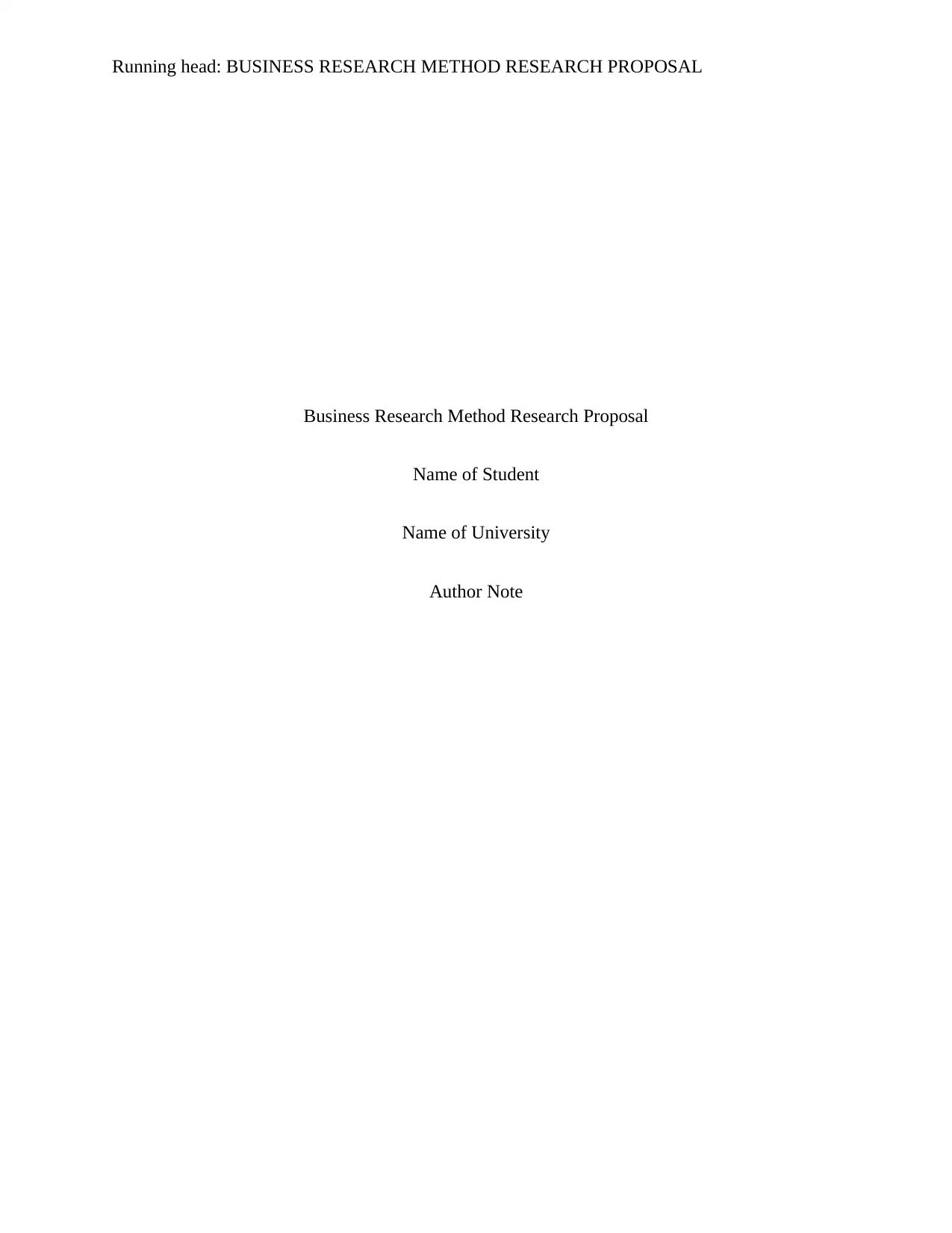
Running head: BUSINESS RESEARCH METHOD RESEARCH PROPOSAL
Business Research Method Research Proposal
Name of Student
Name of University
Author Note
Business Research Method Research Proposal
Name of Student
Name of University
Author Note
Secure Best Marks with AI Grader
Need help grading? Try our AI Grader for instant feedback on your assignments.
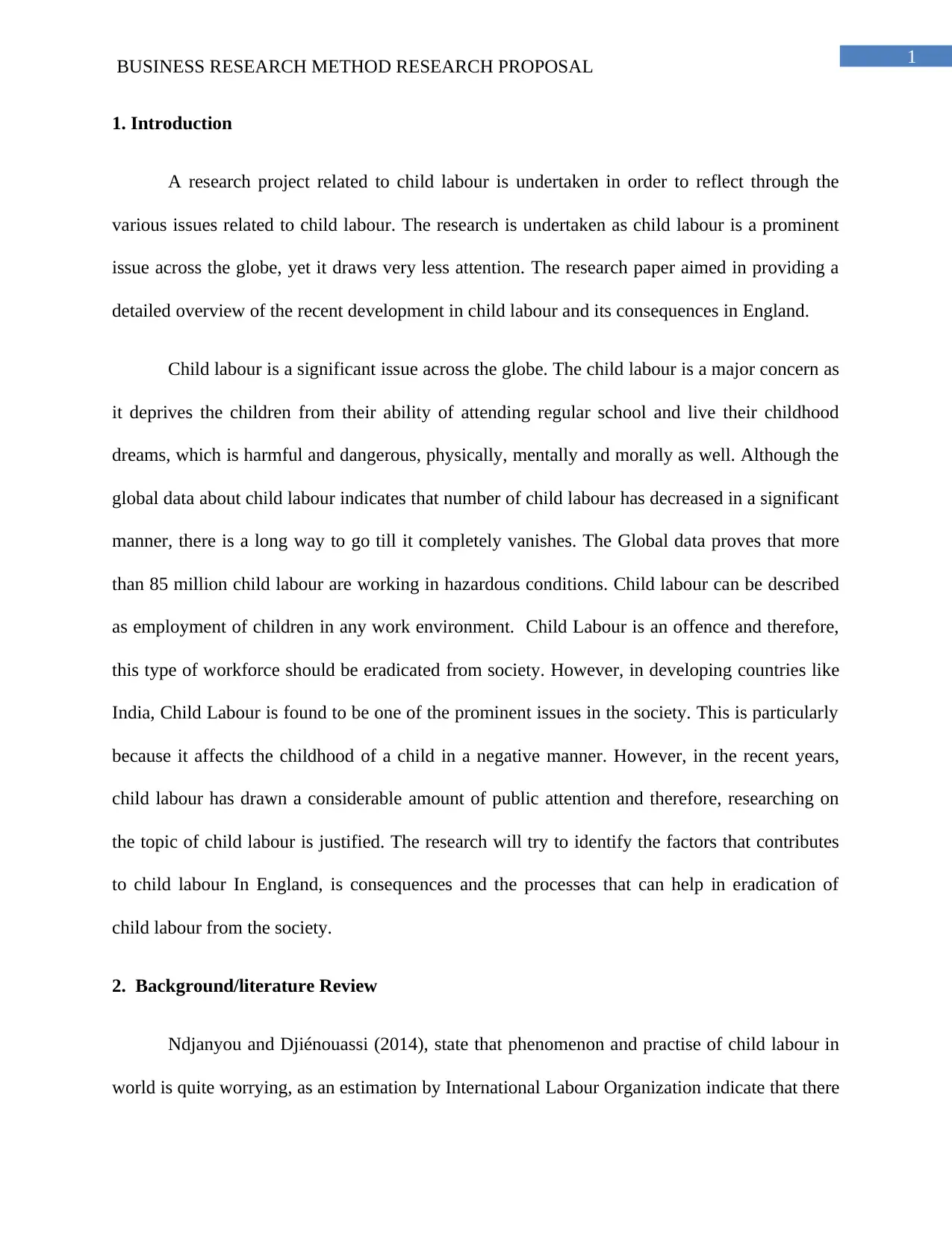
1
BUSINESS RESEARCH METHOD RESEARCH PROPOSAL
1. Introduction
A research project related to child labour is undertaken in order to reflect through the
various issues related to child labour. The research is undertaken as child labour is a prominent
issue across the globe, yet it draws very less attention. The research paper aimed in providing a
detailed overview of the recent development in child labour and its consequences in England.
Child labour is a significant issue across the globe. The child labour is a major concern as
it deprives the children from their ability of attending regular school and live their childhood
dreams, which is harmful and dangerous, physically, mentally and morally as well. Although the
global data about child labour indicates that number of child labour has decreased in a significant
manner, there is a long way to go till it completely vanishes. The Global data proves that more
than 85 million child labour are working in hazardous conditions. Child labour can be described
as employment of children in any work environment. Child Labour is an offence and therefore,
this type of workforce should be eradicated from society. However, in developing countries like
India, Child Labour is found to be one of the prominent issues in the society. This is particularly
because it affects the childhood of a child in a negative manner. However, in the recent years,
child labour has drawn a considerable amount of public attention and therefore, researching on
the topic of child labour is justified. The research will try to identify the factors that contributes
to child labour In England, is consequences and the processes that can help in eradication of
child labour from the society.
2. Background/literature Review
Ndjanyou and Djiénouassi (2014), state that phenomenon and practise of child labour in
world is quite worrying, as an estimation by International Labour Organization indicate that there
BUSINESS RESEARCH METHOD RESEARCH PROPOSAL
1. Introduction
A research project related to child labour is undertaken in order to reflect through the
various issues related to child labour. The research is undertaken as child labour is a prominent
issue across the globe, yet it draws very less attention. The research paper aimed in providing a
detailed overview of the recent development in child labour and its consequences in England.
Child labour is a significant issue across the globe. The child labour is a major concern as
it deprives the children from their ability of attending regular school and live their childhood
dreams, which is harmful and dangerous, physically, mentally and morally as well. Although the
global data about child labour indicates that number of child labour has decreased in a significant
manner, there is a long way to go till it completely vanishes. The Global data proves that more
than 85 million child labour are working in hazardous conditions. Child labour can be described
as employment of children in any work environment. Child Labour is an offence and therefore,
this type of workforce should be eradicated from society. However, in developing countries like
India, Child Labour is found to be one of the prominent issues in the society. This is particularly
because it affects the childhood of a child in a negative manner. However, in the recent years,
child labour has drawn a considerable amount of public attention and therefore, researching on
the topic of child labour is justified. The research will try to identify the factors that contributes
to child labour In England, is consequences and the processes that can help in eradication of
child labour from the society.
2. Background/literature Review
Ndjanyou and Djiénouassi (2014), state that phenomenon and practise of child labour in
world is quite worrying, as an estimation by International Labour Organization indicate that there
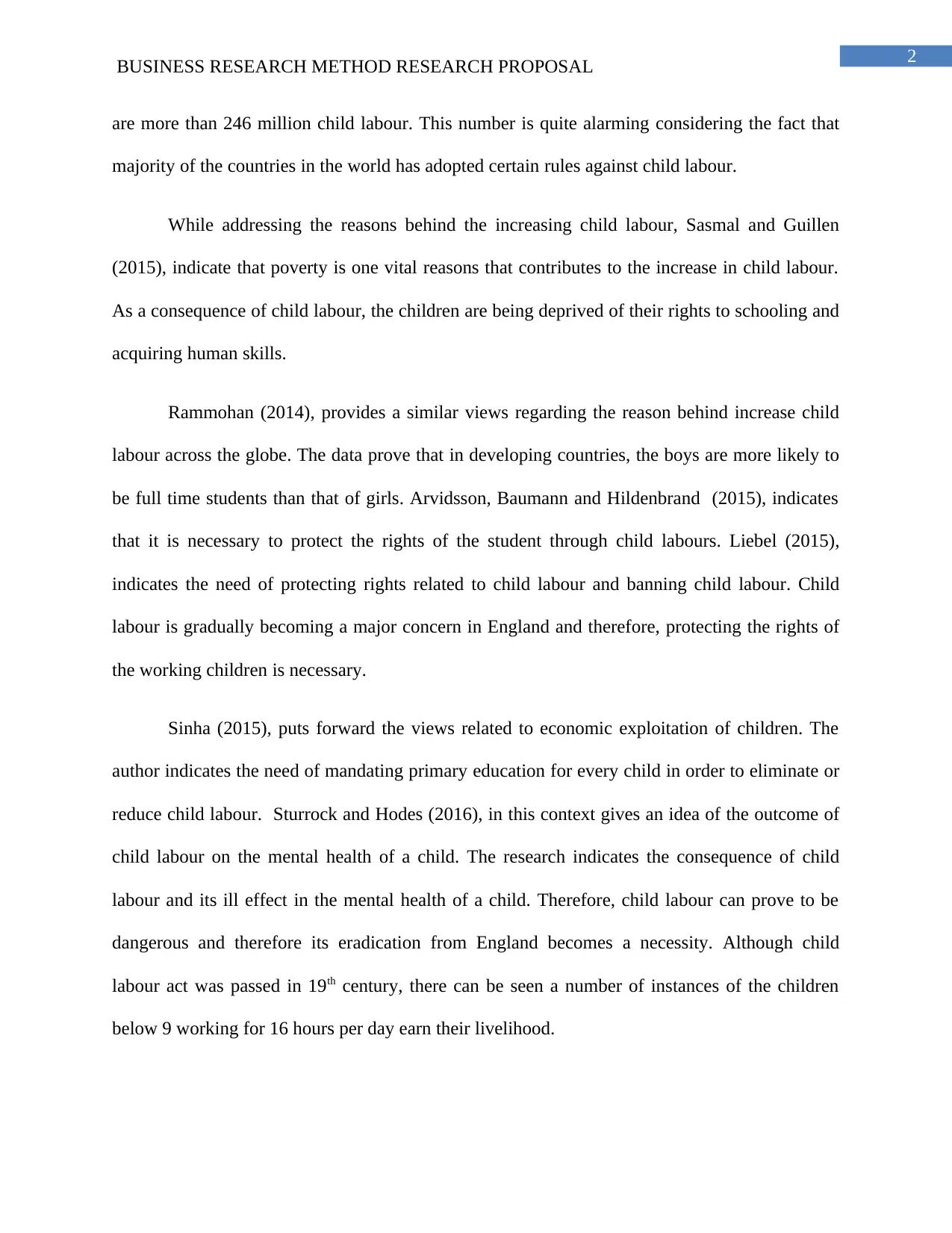
2
BUSINESS RESEARCH METHOD RESEARCH PROPOSAL
are more than 246 million child labour. This number is quite alarming considering the fact that
majority of the countries in the world has adopted certain rules against child labour.
While addressing the reasons behind the increasing child labour, Sasmal and Guillen
(2015), indicate that poverty is one vital reasons that contributes to the increase in child labour.
As a consequence of child labour, the children are being deprived of their rights to schooling and
acquiring human skills.
Rammohan (2014), provides a similar views regarding the reason behind increase child
labour across the globe. The data prove that in developing countries, the boys are more likely to
be full time students than that of girls. Arvidsson, Baumann and Hildenbrand (2015), indicates
that it is necessary to protect the rights of the student through child labours. Liebel (2015),
indicates the need of protecting rights related to child labour and banning child labour. Child
labour is gradually becoming a major concern in England and therefore, protecting the rights of
the working children is necessary.
Sinha (2015), puts forward the views related to economic exploitation of children. The
author indicates the need of mandating primary education for every child in order to eliminate or
reduce child labour. Sturrock and Hodes (2016), in this context gives an idea of the outcome of
child labour on the mental health of a child. The research indicates the consequence of child
labour and its ill effect in the mental health of a child. Therefore, child labour can prove to be
dangerous and therefore its eradication from England becomes a necessity. Although child
labour act was passed in 19th century, there can be seen a number of instances of the children
below 9 working for 16 hours per day earn their livelihood.
BUSINESS RESEARCH METHOD RESEARCH PROPOSAL
are more than 246 million child labour. This number is quite alarming considering the fact that
majority of the countries in the world has adopted certain rules against child labour.
While addressing the reasons behind the increasing child labour, Sasmal and Guillen
(2015), indicate that poverty is one vital reasons that contributes to the increase in child labour.
As a consequence of child labour, the children are being deprived of their rights to schooling and
acquiring human skills.
Rammohan (2014), provides a similar views regarding the reason behind increase child
labour across the globe. The data prove that in developing countries, the boys are more likely to
be full time students than that of girls. Arvidsson, Baumann and Hildenbrand (2015), indicates
that it is necessary to protect the rights of the student through child labours. Liebel (2015),
indicates the need of protecting rights related to child labour and banning child labour. Child
labour is gradually becoming a major concern in England and therefore, protecting the rights of
the working children is necessary.
Sinha (2015), puts forward the views related to economic exploitation of children. The
author indicates the need of mandating primary education for every child in order to eliminate or
reduce child labour. Sturrock and Hodes (2016), in this context gives an idea of the outcome of
child labour on the mental health of a child. The research indicates the consequence of child
labour and its ill effect in the mental health of a child. Therefore, child labour can prove to be
dangerous and therefore its eradication from England becomes a necessity. Although child
labour act was passed in 19th century, there can be seen a number of instances of the children
below 9 working for 16 hours per day earn their livelihood.
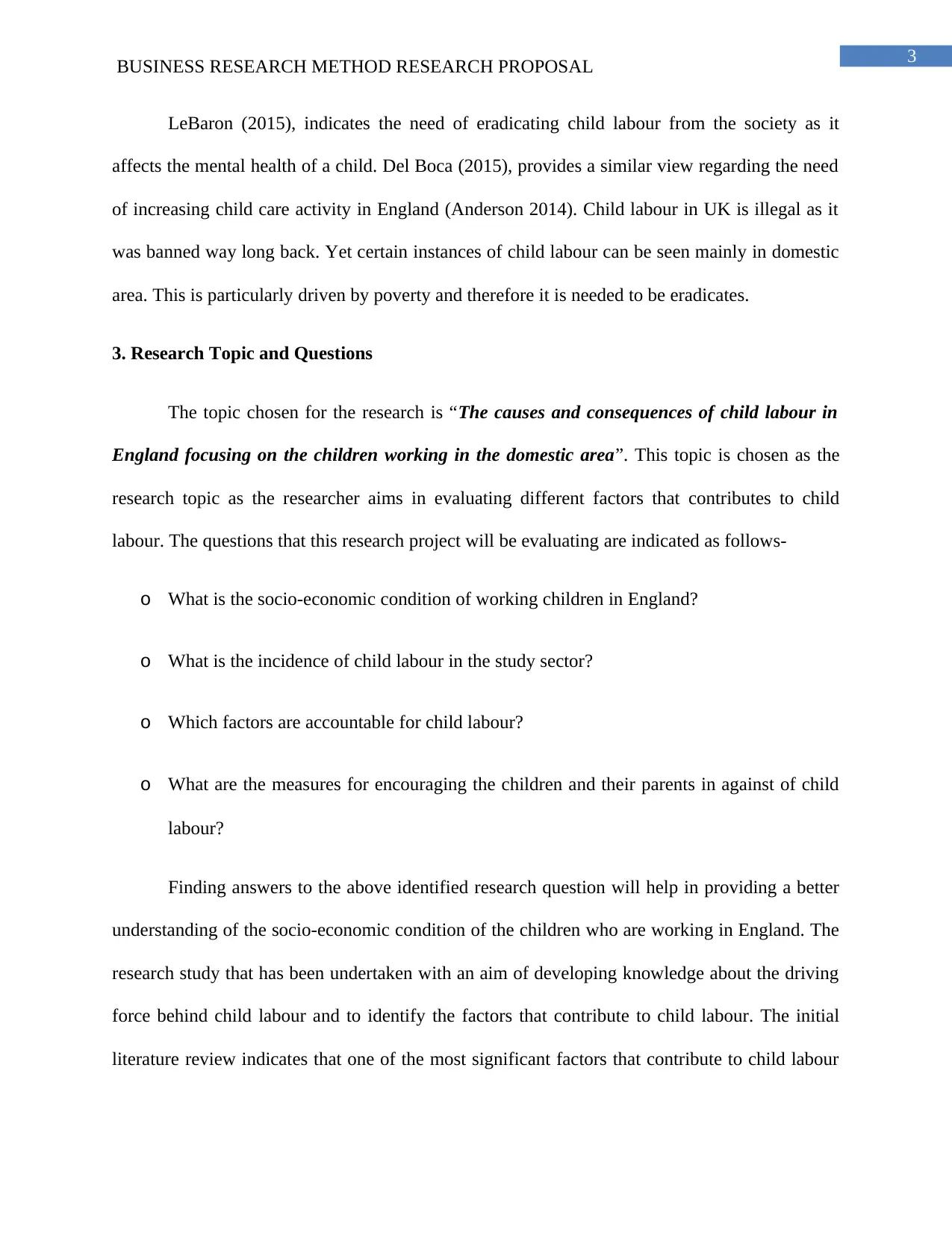
3
BUSINESS RESEARCH METHOD RESEARCH PROPOSAL
LeBaron (2015), indicates the need of eradicating child labour from the society as it
affects the mental health of a child. Del Boca (2015), provides a similar view regarding the need
of increasing child care activity in England (Anderson 2014). Child labour in UK is illegal as it
was banned way long back. Yet certain instances of child labour can be seen mainly in domestic
area. This is particularly driven by poverty and therefore it is needed to be eradicates.
3. Research Topic and Questions
The topic chosen for the research is “The causes and consequences of child labour in
England focusing on the children working in the domestic area”. This topic is chosen as the
research topic as the researcher aims in evaluating different factors that contributes to child
labour. The questions that this research project will be evaluating are indicated as follows-
o What is the socio-economic condition of working children in England?
o What is the incidence of child labour in the study sector?
o Which factors are accountable for child labour?
o What are the measures for encouraging the children and their parents in against of child
labour?
Finding answers to the above identified research question will help in providing a better
understanding of the socio-economic condition of the children who are working in England. The
research study that has been undertaken with an aim of developing knowledge about the driving
force behind child labour and to identify the factors that contribute to child labour. The initial
literature review indicates that one of the most significant factors that contribute to child labour
BUSINESS RESEARCH METHOD RESEARCH PROPOSAL
LeBaron (2015), indicates the need of eradicating child labour from the society as it
affects the mental health of a child. Del Boca (2015), provides a similar view regarding the need
of increasing child care activity in England (Anderson 2014). Child labour in UK is illegal as it
was banned way long back. Yet certain instances of child labour can be seen mainly in domestic
area. This is particularly driven by poverty and therefore it is needed to be eradicates.
3. Research Topic and Questions
The topic chosen for the research is “The causes and consequences of child labour in
England focusing on the children working in the domestic area”. This topic is chosen as the
research topic as the researcher aims in evaluating different factors that contributes to child
labour. The questions that this research project will be evaluating are indicated as follows-
o What is the socio-economic condition of working children in England?
o What is the incidence of child labour in the study sector?
o Which factors are accountable for child labour?
o What are the measures for encouraging the children and their parents in against of child
labour?
Finding answers to the above identified research question will help in providing a better
understanding of the socio-economic condition of the children who are working in England. The
research study that has been undertaken with an aim of developing knowledge about the driving
force behind child labour and to identify the factors that contribute to child labour. The initial
literature review indicates that one of the most significant factors that contribute to child labour
Secure Best Marks with AI Grader
Need help grading? Try our AI Grader for instant feedback on your assignments.
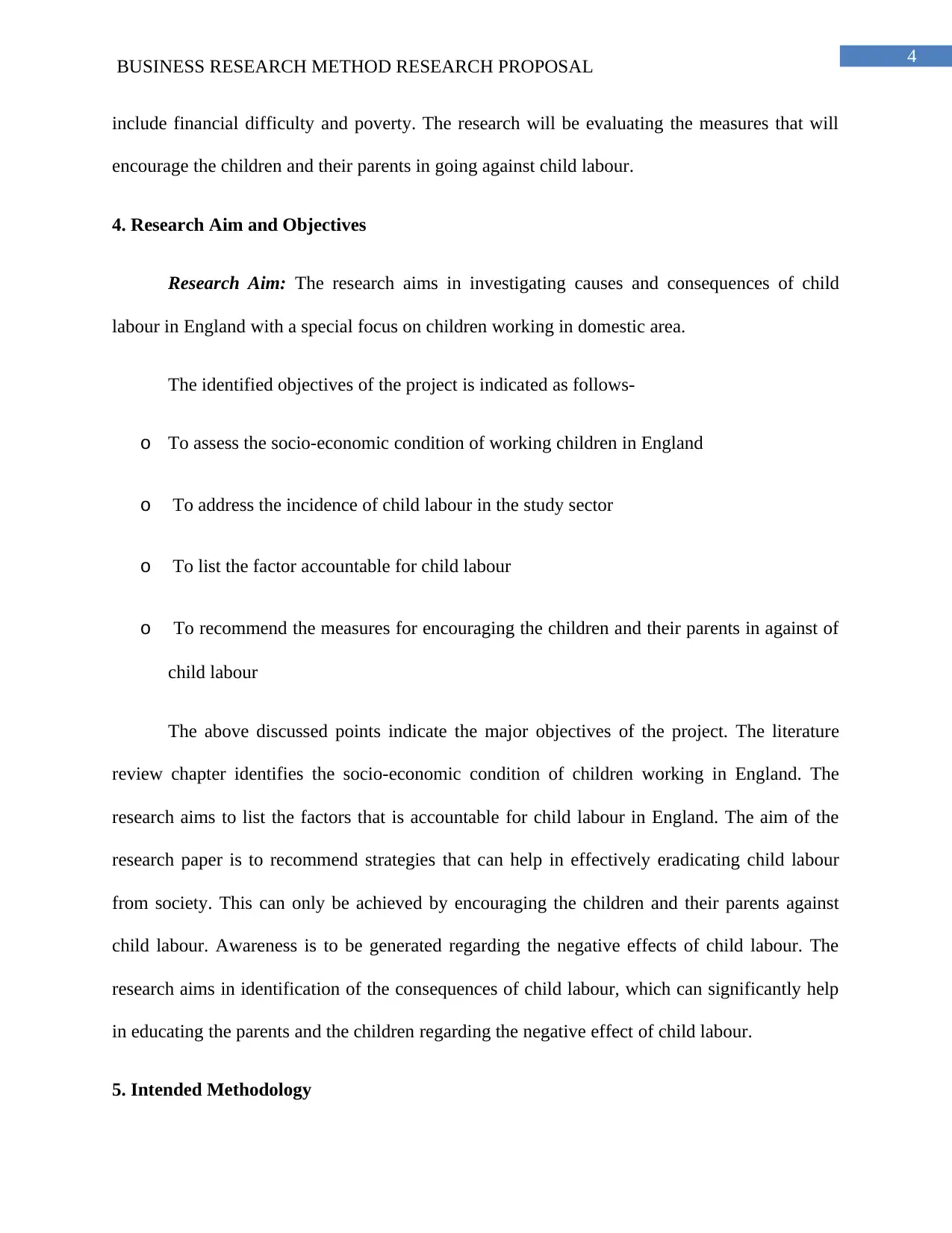
4
BUSINESS RESEARCH METHOD RESEARCH PROPOSAL
include financial difficulty and poverty. The research will be evaluating the measures that will
encourage the children and their parents in going against child labour.
4. Research Aim and Objectives
Research Aim: The research aims in investigating causes and consequences of child
labour in England with a special focus on children working in domestic area.
The identified objectives of the project is indicated as follows-
o To assess the socio-economic condition of working children in England
o To address the incidence of child labour in the study sector
o To list the factor accountable for child labour
o To recommend the measures for encouraging the children and their parents in against of
child labour
The above discussed points indicate the major objectives of the project. The literature
review chapter identifies the socio-economic condition of children working in England. The
research aims to list the factors that is accountable for child labour in England. The aim of the
research paper is to recommend strategies that can help in effectively eradicating child labour
from society. This can only be achieved by encouraging the children and their parents against
child labour. Awareness is to be generated regarding the negative effects of child labour. The
research aims in identification of the consequences of child labour, which can significantly help
in educating the parents and the children regarding the negative effect of child labour.
5. Intended Methodology
BUSINESS RESEARCH METHOD RESEARCH PROPOSAL
include financial difficulty and poverty. The research will be evaluating the measures that will
encourage the children and their parents in going against child labour.
4. Research Aim and Objectives
Research Aim: The research aims in investigating causes and consequences of child
labour in England with a special focus on children working in domestic area.
The identified objectives of the project is indicated as follows-
o To assess the socio-economic condition of working children in England
o To address the incidence of child labour in the study sector
o To list the factor accountable for child labour
o To recommend the measures for encouraging the children and their parents in against of
child labour
The above discussed points indicate the major objectives of the project. The literature
review chapter identifies the socio-economic condition of children working in England. The
research aims to list the factors that is accountable for child labour in England. The aim of the
research paper is to recommend strategies that can help in effectively eradicating child labour
from society. This can only be achieved by encouraging the children and their parents against
child labour. Awareness is to be generated regarding the negative effects of child labour. The
research aims in identification of the consequences of child labour, which can significantly help
in educating the parents and the children regarding the negative effect of child labour.
5. Intended Methodology
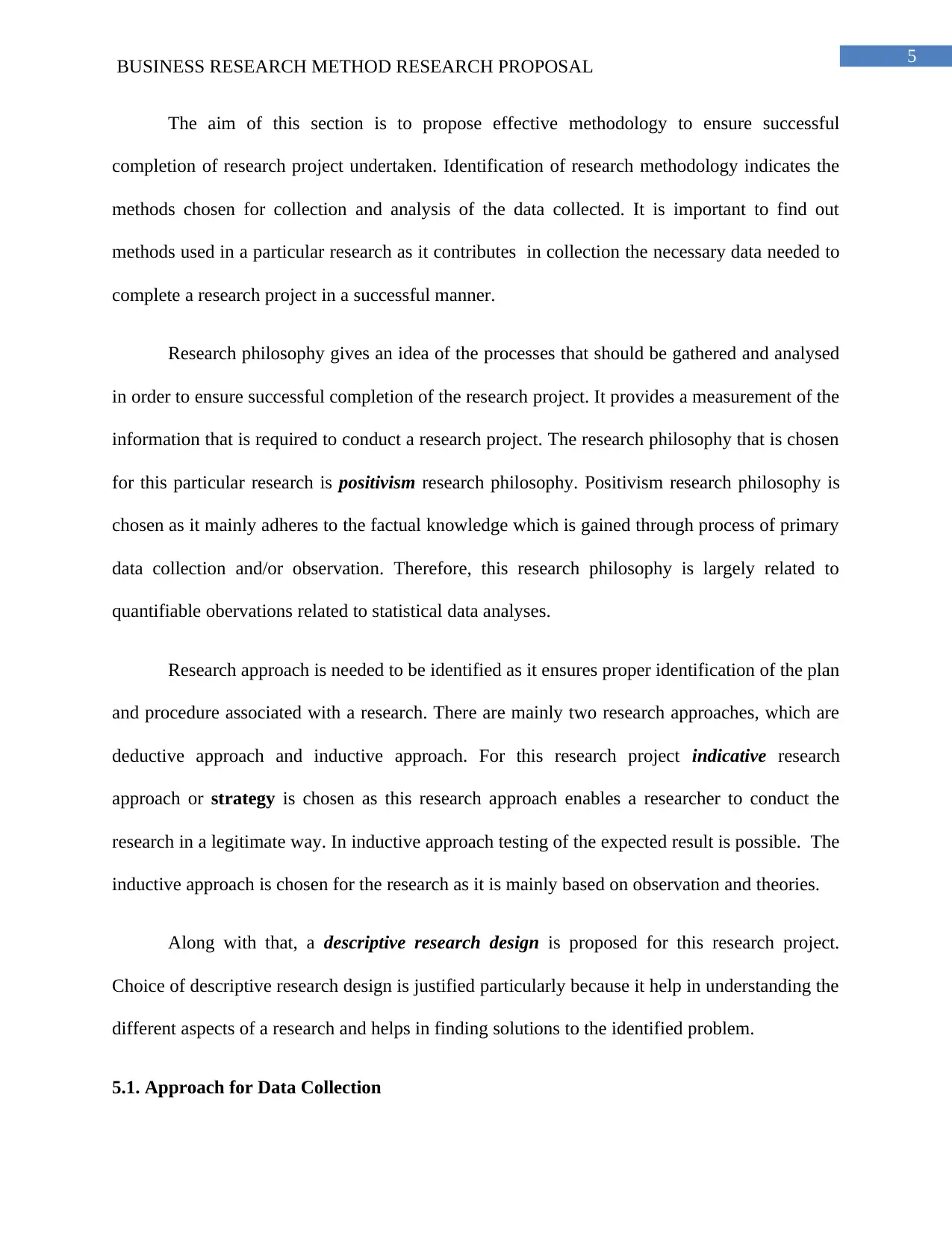
5
BUSINESS RESEARCH METHOD RESEARCH PROPOSAL
The aim of this section is to propose effective methodology to ensure successful
completion of research project undertaken. Identification of research methodology indicates the
methods chosen for collection and analysis of the data collected. It is important to find out
methods used in a particular research as it contributes in collection the necessary data needed to
complete a research project in a successful manner.
Research philosophy gives an idea of the processes that should be gathered and analysed
in order to ensure successful completion of the research project. It provides a measurement of the
information that is required to conduct a research project. The research philosophy that is chosen
for this particular research is positivism research philosophy. Positivism research philosophy is
chosen as it mainly adheres to the factual knowledge which is gained through process of primary
data collection and/or observation. Therefore, this research philosophy is largely related to
quantifiable obervations related to statistical data analyses.
Research approach is needed to be identified as it ensures proper identification of the plan
and procedure associated with a research. There are mainly two research approaches, which are
deductive approach and inductive approach. For this research project indicative research
approach or strategy is chosen as this research approach enables a researcher to conduct the
research in a legitimate way. In inductive approach testing of the expected result is possible. The
inductive approach is chosen for the research as it is mainly based on observation and theories.
Along with that, a descriptive research design is proposed for this research project.
Choice of descriptive research design is justified particularly because it help in understanding the
different aspects of a research and helps in finding solutions to the identified problem.
5.1. Approach for Data Collection
BUSINESS RESEARCH METHOD RESEARCH PROPOSAL
The aim of this section is to propose effective methodology to ensure successful
completion of research project undertaken. Identification of research methodology indicates the
methods chosen for collection and analysis of the data collected. It is important to find out
methods used in a particular research as it contributes in collection the necessary data needed to
complete a research project in a successful manner.
Research philosophy gives an idea of the processes that should be gathered and analysed
in order to ensure successful completion of the research project. It provides a measurement of the
information that is required to conduct a research project. The research philosophy that is chosen
for this particular research is positivism research philosophy. Positivism research philosophy is
chosen as it mainly adheres to the factual knowledge which is gained through process of primary
data collection and/or observation. Therefore, this research philosophy is largely related to
quantifiable obervations related to statistical data analyses.
Research approach is needed to be identified as it ensures proper identification of the plan
and procedure associated with a research. There are mainly two research approaches, which are
deductive approach and inductive approach. For this research project indicative research
approach or strategy is chosen as this research approach enables a researcher to conduct the
research in a legitimate way. In inductive approach testing of the expected result is possible. The
inductive approach is chosen for the research as it is mainly based on observation and theories.
Along with that, a descriptive research design is proposed for this research project.
Choice of descriptive research design is justified particularly because it help in understanding the
different aspects of a research and helps in finding solutions to the identified problem.
5.1. Approach for Data Collection
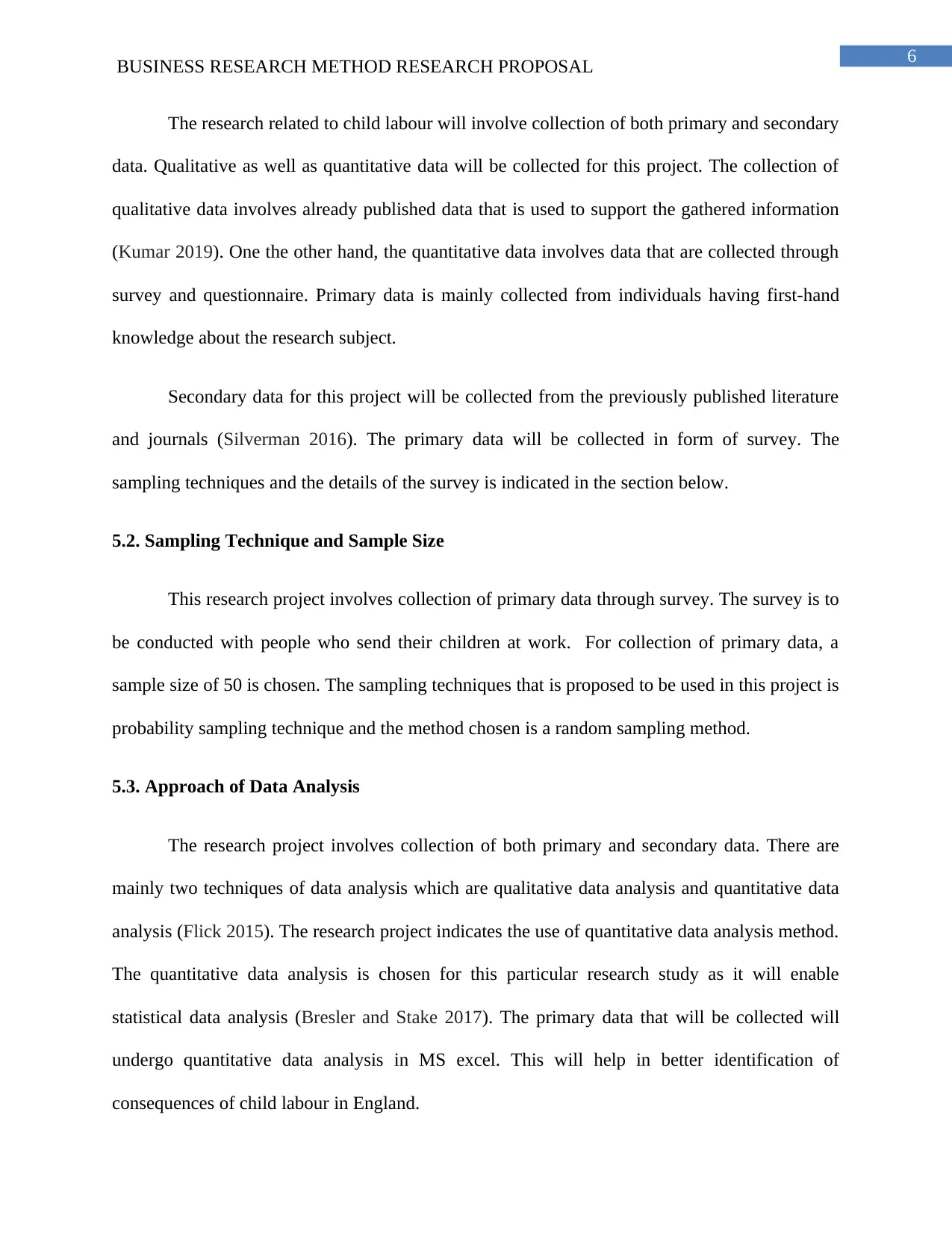
6
BUSINESS RESEARCH METHOD RESEARCH PROPOSAL
The research related to child labour will involve collection of both primary and secondary
data. Qualitative as well as quantitative data will be collected for this project. The collection of
qualitative data involves already published data that is used to support the gathered information
(Kumar 2019). One the other hand, the quantitative data involves data that are collected through
survey and questionnaire. Primary data is mainly collected from individuals having first-hand
knowledge about the research subject.
Secondary data for this project will be collected from the previously published literature
and journals (Silverman 2016). The primary data will be collected in form of survey. The
sampling techniques and the details of the survey is indicated in the section below.
5.2. Sampling Technique and Sample Size
This research project involves collection of primary data through survey. The survey is to
be conducted with people who send their children at work. For collection of primary data, a
sample size of 50 is chosen. The sampling techniques that is proposed to be used in this project is
probability sampling technique and the method chosen is a random sampling method.
5.3. Approach of Data Analysis
The research project involves collection of both primary and secondary data. There are
mainly two techniques of data analysis which are qualitative data analysis and quantitative data
analysis (Flick 2015). The research project indicates the use of quantitative data analysis method.
The quantitative data analysis is chosen for this particular research study as it will enable
statistical data analysis (Bresler and Stake 2017). The primary data that will be collected will
undergo quantitative data analysis in MS excel. This will help in better identification of
consequences of child labour in England.
BUSINESS RESEARCH METHOD RESEARCH PROPOSAL
The research related to child labour will involve collection of both primary and secondary
data. Qualitative as well as quantitative data will be collected for this project. The collection of
qualitative data involves already published data that is used to support the gathered information
(Kumar 2019). One the other hand, the quantitative data involves data that are collected through
survey and questionnaire. Primary data is mainly collected from individuals having first-hand
knowledge about the research subject.
Secondary data for this project will be collected from the previously published literature
and journals (Silverman 2016). The primary data will be collected in form of survey. The
sampling techniques and the details of the survey is indicated in the section below.
5.2. Sampling Technique and Sample Size
This research project involves collection of primary data through survey. The survey is to
be conducted with people who send their children at work. For collection of primary data, a
sample size of 50 is chosen. The sampling techniques that is proposed to be used in this project is
probability sampling technique and the method chosen is a random sampling method.
5.3. Approach of Data Analysis
The research project involves collection of both primary and secondary data. There are
mainly two techniques of data analysis which are qualitative data analysis and quantitative data
analysis (Flick 2015). The research project indicates the use of quantitative data analysis method.
The quantitative data analysis is chosen for this particular research study as it will enable
statistical data analysis (Bresler and Stake 2017). The primary data that will be collected will
undergo quantitative data analysis in MS excel. This will help in better identification of
consequences of child labour in England.
Paraphrase This Document
Need a fresh take? Get an instant paraphrase of this document with our AI Paraphraser
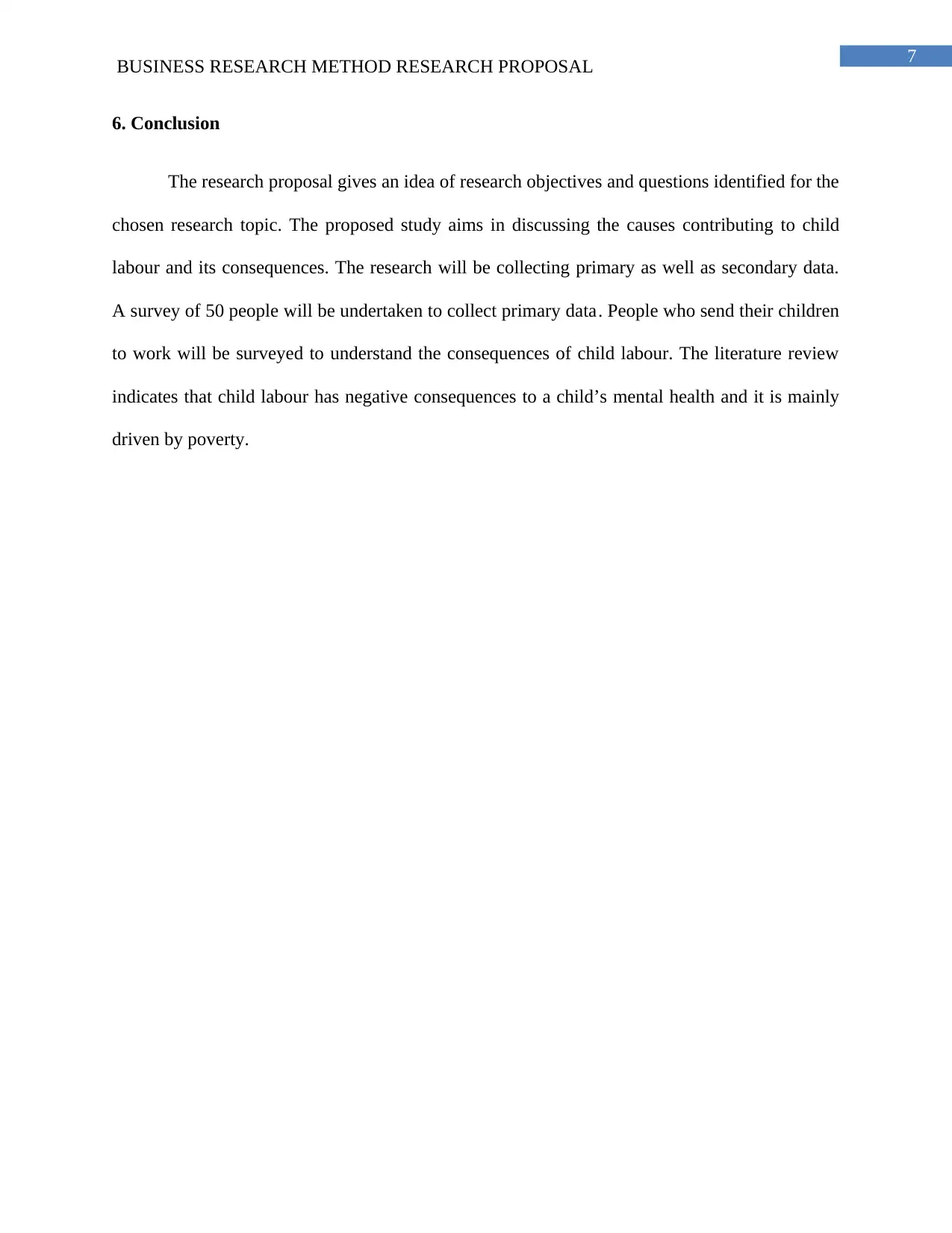
7
BUSINESS RESEARCH METHOD RESEARCH PROPOSAL
6. Conclusion
The research proposal gives an idea of research objectives and questions identified for the
chosen research topic. The proposed study aims in discussing the causes contributing to child
labour and its consequences. The research will be collecting primary as well as secondary data.
A survey of 50 people will be undertaken to collect primary data. People who send their children
to work will be surveyed to understand the consequences of child labour. The literature review
indicates that child labour has negative consequences to a child’s mental health and it is mainly
driven by poverty.
BUSINESS RESEARCH METHOD RESEARCH PROPOSAL
6. Conclusion
The research proposal gives an idea of research objectives and questions identified for the
chosen research topic. The proposed study aims in discussing the causes contributing to child
labour and its consequences. The research will be collecting primary as well as secondary data.
A survey of 50 people will be undertaken to collect primary data. People who send their children
to work will be surveyed to understand the consequences of child labour. The literature review
indicates that child labour has negative consequences to a child’s mental health and it is mainly
driven by poverty.
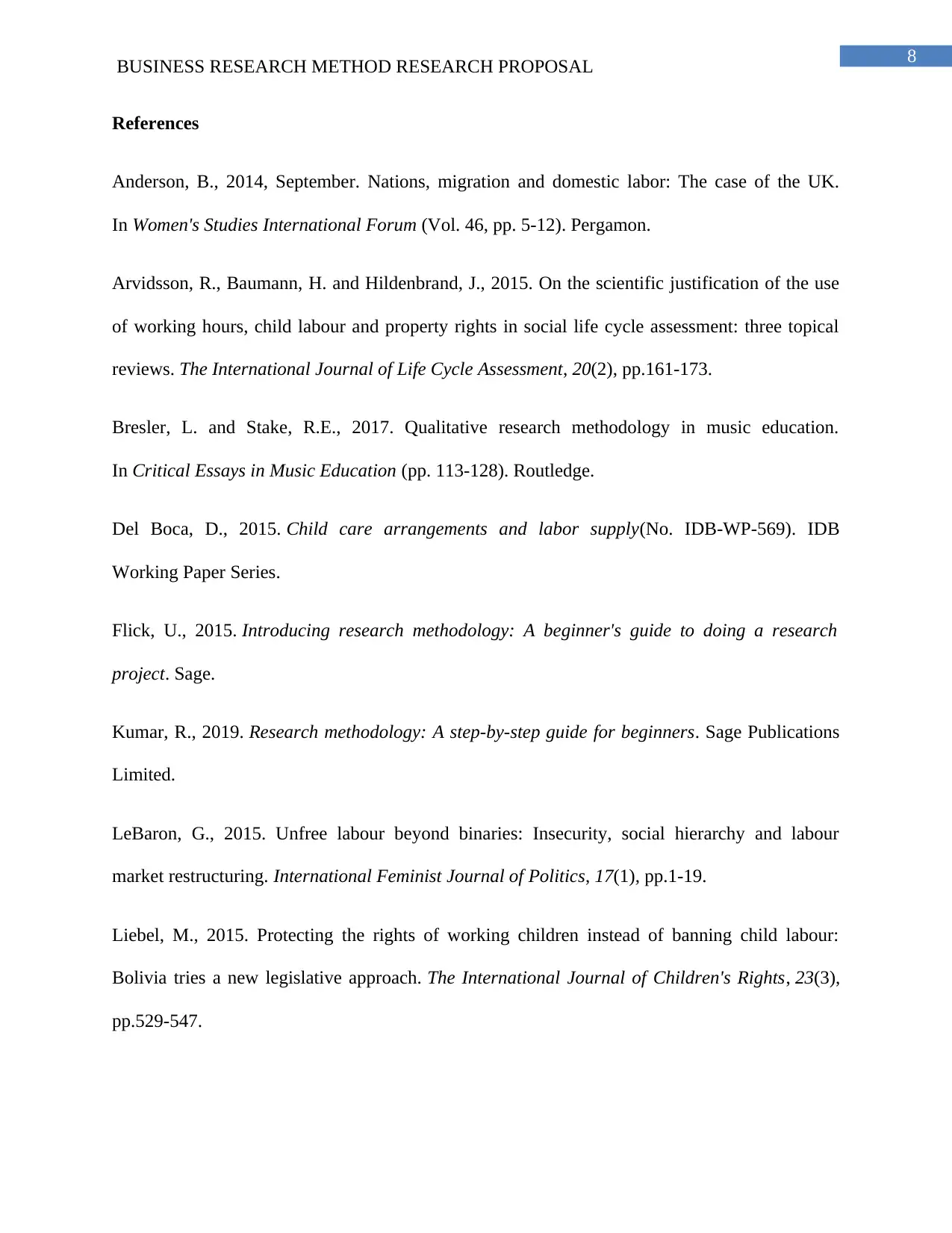
8
BUSINESS RESEARCH METHOD RESEARCH PROPOSAL
References
Anderson, B., 2014, September. Nations, migration and domestic labor: The case of the UK.
In Women's Studies International Forum (Vol. 46, pp. 5-12). Pergamon.
Arvidsson, R., Baumann, H. and Hildenbrand, J., 2015. On the scientific justification of the use
of working hours, child labour and property rights in social life cycle assessment: three topical
reviews. The International Journal of Life Cycle Assessment, 20(2), pp.161-173.
Bresler, L. and Stake, R.E., 2017. Qualitative research methodology in music education.
In Critical Essays in Music Education (pp. 113-128). Routledge.
Del Boca, D., 2015. Child care arrangements and labor supply(No. IDB-WP-569). IDB
Working Paper Series.
Flick, U., 2015. Introducing research methodology: A beginner's guide to doing a research
project. Sage.
Kumar, R., 2019. Research methodology: A step-by-step guide for beginners. Sage Publications
Limited.
LeBaron, G., 2015. Unfree labour beyond binaries: Insecurity, social hierarchy and labour
market restructuring. International Feminist Journal of Politics, 17(1), pp.1-19.
Liebel, M., 2015. Protecting the rights of working children instead of banning child labour:
Bolivia tries a new legislative approach. The International Journal of Children's Rights, 23(3),
pp.529-547.
BUSINESS RESEARCH METHOD RESEARCH PROPOSAL
References
Anderson, B., 2014, September. Nations, migration and domestic labor: The case of the UK.
In Women's Studies International Forum (Vol. 46, pp. 5-12). Pergamon.
Arvidsson, R., Baumann, H. and Hildenbrand, J., 2015. On the scientific justification of the use
of working hours, child labour and property rights in social life cycle assessment: three topical
reviews. The International Journal of Life Cycle Assessment, 20(2), pp.161-173.
Bresler, L. and Stake, R.E., 2017. Qualitative research methodology in music education.
In Critical Essays in Music Education (pp. 113-128). Routledge.
Del Boca, D., 2015. Child care arrangements and labor supply(No. IDB-WP-569). IDB
Working Paper Series.
Flick, U., 2015. Introducing research methodology: A beginner's guide to doing a research
project. Sage.
Kumar, R., 2019. Research methodology: A step-by-step guide for beginners. Sage Publications
Limited.
LeBaron, G., 2015. Unfree labour beyond binaries: Insecurity, social hierarchy and labour
market restructuring. International Feminist Journal of Politics, 17(1), pp.1-19.
Liebel, M., 2015. Protecting the rights of working children instead of banning child labour:
Bolivia tries a new legislative approach. The International Journal of Children's Rights, 23(3),
pp.529-547.
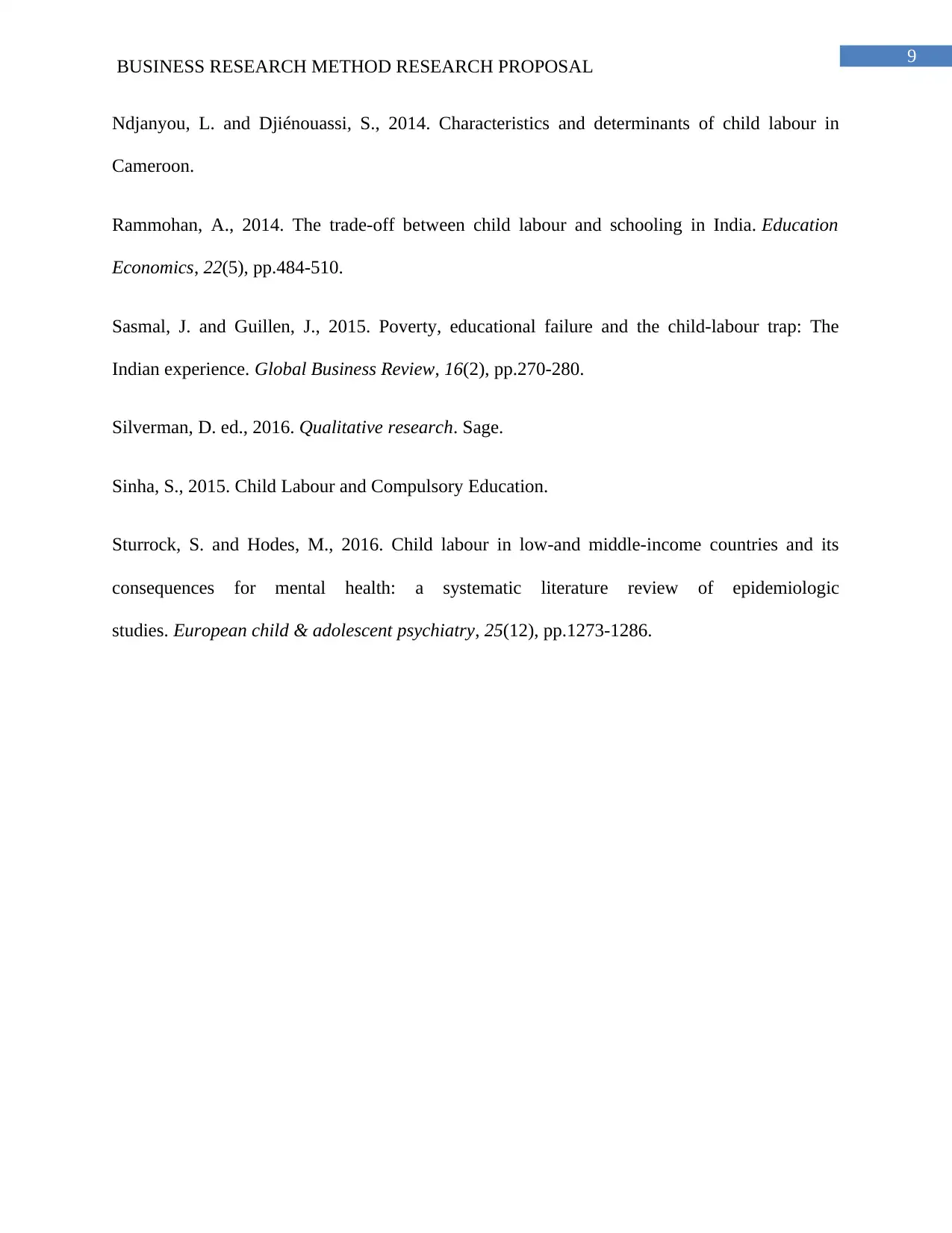
9
BUSINESS RESEARCH METHOD RESEARCH PROPOSAL
Ndjanyou, L. and Djiénouassi, S., 2014. Characteristics and determinants of child labour in
Cameroon.
Rammohan, A., 2014. The trade-off between child labour and schooling in India. Education
Economics, 22(5), pp.484-510.
Sasmal, J. and Guillen, J., 2015. Poverty, educational failure and the child-labour trap: The
Indian experience. Global Business Review, 16(2), pp.270-280.
Silverman, D. ed., 2016. Qualitative research. Sage.
Sinha, S., 2015. Child Labour and Compulsory Education.
Sturrock, S. and Hodes, M., 2016. Child labour in low-and middle-income countries and its
consequences for mental health: a systematic literature review of epidemiologic
studies. European child & adolescent psychiatry, 25(12), pp.1273-1286.
BUSINESS RESEARCH METHOD RESEARCH PROPOSAL
Ndjanyou, L. and Djiénouassi, S., 2014. Characteristics and determinants of child labour in
Cameroon.
Rammohan, A., 2014. The trade-off between child labour and schooling in India. Education
Economics, 22(5), pp.484-510.
Sasmal, J. and Guillen, J., 2015. Poverty, educational failure and the child-labour trap: The
Indian experience. Global Business Review, 16(2), pp.270-280.
Silverman, D. ed., 2016. Qualitative research. Sage.
Sinha, S., 2015. Child Labour and Compulsory Education.
Sturrock, S. and Hodes, M., 2016. Child labour in low-and middle-income countries and its
consequences for mental health: a systematic literature review of epidemiologic
studies. European child & adolescent psychiatry, 25(12), pp.1273-1286.
Secure Best Marks with AI Grader
Need help grading? Try our AI Grader for instant feedback on your assignments.
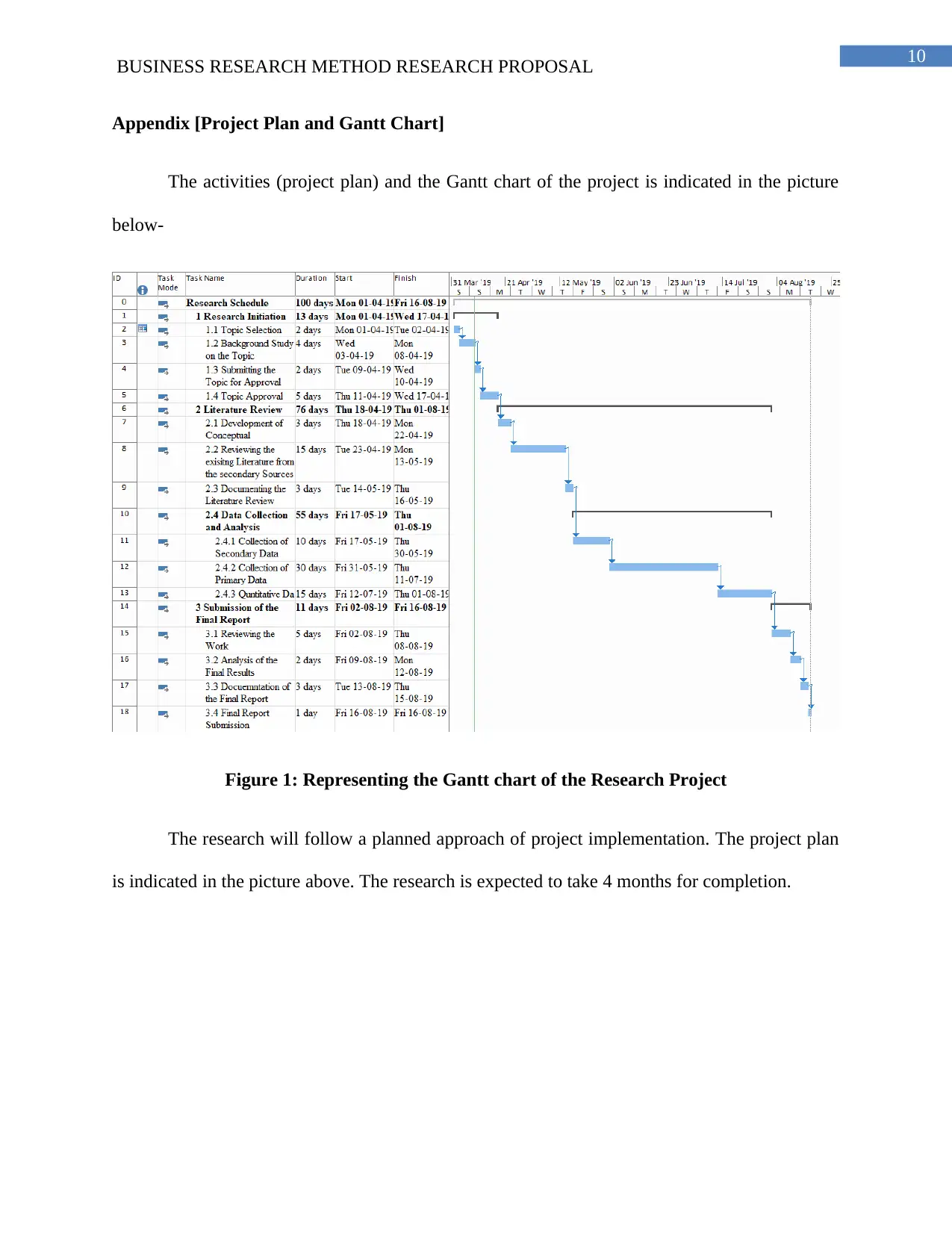
10
BUSINESS RESEARCH METHOD RESEARCH PROPOSAL
Appendix [Project Plan and Gantt Chart]
The activities (project plan) and the Gantt chart of the project is indicated in the picture
below-
Figure 1: Representing the Gantt chart of the Research Project
The research will follow a planned approach of project implementation. The project plan
is indicated in the picture above. The research is expected to take 4 months for completion.
BUSINESS RESEARCH METHOD RESEARCH PROPOSAL
Appendix [Project Plan and Gantt Chart]
The activities (project plan) and the Gantt chart of the project is indicated in the picture
below-
Figure 1: Representing the Gantt chart of the Research Project
The research will follow a planned approach of project implementation. The project plan
is indicated in the picture above. The research is expected to take 4 months for completion.

11
BUSINESS RESEARCH METHOD RESEARCH PROPOSAL
BUSINESS RESEARCH METHOD RESEARCH PROPOSAL
1 out of 12
Related Documents
Your All-in-One AI-Powered Toolkit for Academic Success.
+13062052269
info@desklib.com
Available 24*7 on WhatsApp / Email
![[object Object]](/_next/static/media/star-bottom.7253800d.svg)
Unlock your academic potential
© 2024 | Zucol Services PVT LTD | All rights reserved.


